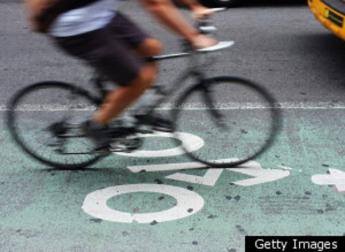
By Lynne Peeples Like a growing number of Americans, Jonathan Patz rides his bike to work. He even drags a wheeled blue bin behind his bike for trips to the grocery store. Sure, this environmental scientist naturally wants to do his part to preserve the planet''s future, but his motivation is also personal: He knows his wallet, waistline, heart, lungs and neighbors will benefit today. "If we were to think about reducing greenhouse gases to solve the global warming problem, we could have some immediate major health benefits," says Patz, director of the Global Health Institute at the University of Wisconsin, Madison, and lead author of a new study highlighting the "four-way win" that comes with swapping cars for bikes: reduced greenhouse emissions and gains in air quality, fitness and the economy. Patz is also a professor in Madison''s Nelson Institute and Department of Population Health Sciences. In the study, published today in Environmental Health Perspectives, Patz and his colleagues looked to the more than 30 million people residing in urban and suburban areas of Illinois, Indiana, Michigan, Minnesota, Ohio and Wisconsin. They asked: What if during the nicest six months of the year, those residents left their cars at home for round-trips of five miles or less? And what if they chose to replace half of those short car trips, which account for about 20 percent of all vehicle miles traveled, with cycling? According to their calculations, making those short trips on bicycles could save approximately four trillion pounds of carbon dioxide emissions, 1,100 lives and $7 billion in mortality and health care costs for the region every year. "Fighting global climate change could be one of the greatest public health opportunities we''ve had in a century," Patz told Dalai Lama Tenzin Gyatso last month in the Tibetan leader''s home in Dharamsala, India. "This is where I look to your wisdom and writing," he added. "Everything starts with the individual — we start with ourselves." "Wonderful," Dalai Lama replied, bowing his head to Patz. "Wonderful. Very good." Michael Brauer likes the idea, too. Every day, he rides his bike to The University of British Columbia in Vancouver, where he is a professor of population and public health. He chooses to pedal partly for the physical activity and partly because he simply enjoys it more than driving. But not all cities are as bike-friendly as Vancouver or Madison, the latter having earned the League of American Bicyclists'' "gold-certification." And then there''s "platinum" Boulder, Colo., where Brauer claims you can "cycle through the city without coming into contact with cars." He suggests the benchmarks used in the study are "aspirational" but not realistic, at least not in the short term. "Many people cannot get anywhere even if they want to by choosing to walk or cycle for short trips," says Brauer. Neighborhoods are simply not designed that way: Roads may not be connected or amenities may be too far from residences. Brauer also notes that the new study does not account for the air pollution risks and physical hazards bikers face on urban roads. Still, that doesn''t deter him from biking. The benefits far outweigh the costs, he tells HuffPost. (Researchers in Holland calculated the benefit-to-cost ratio at nine-to-one.) Further, Brauer suggests that any health trade-offs could easily be eliminated by separating bike lanes from busy car thoroughfares, as is currently being done in Manhattan. Even better, designating every second street exclusively for cars or bikes would simultaneously address the air pollution issue. "It doesn''t have to be fancy or complicated," he says. Or expensive: Considering the money that could be saved, urban biking can even make good economic sense. "Think about the costs of the way our cities and transportation networks are designed now," says Brauer. "If you made some changes to reduce the related health costs, that money could be used to pay for better infrastructure." Bike-friendly additions might include share programs and additional bike racks on buses and curbside. European nations have been pursuing similar changes for decades, with promising successes. Patz suggests that the behavioral changes reflected in his study — even if implemented solely in the upper Midwest — would be equivalent to bringing the entire country in alignment with the national ozone standard. As it turns out, a large fraction of dirty emissions come out of the tailpipe within the first few minutes of starting a car. Cutting short trips therefore provides a disproportionately large reduction in particulate matter and other dangerous pollution. Patz points to a natural case study: the 1996 Summer Olympics in Atlanta. During the games, the city experienced a 23 percent reduction in morning traffic, a 28 percent drop in peak levels of ozone pollution and 42 percent fewer emergency room visits from children suffering asthma attacks. "And any improvement in air quality benefits the entire population, so in aggregate the public health benefits of even relatively small improvements can be large," adds Brauer. "These health costs and benefits clearly should be incorporated into transportation infrastructure planning." "We need to make our cities not just built for automobiles," Patz says, "but built for people." Article courtesy of huffingtonpost.com

